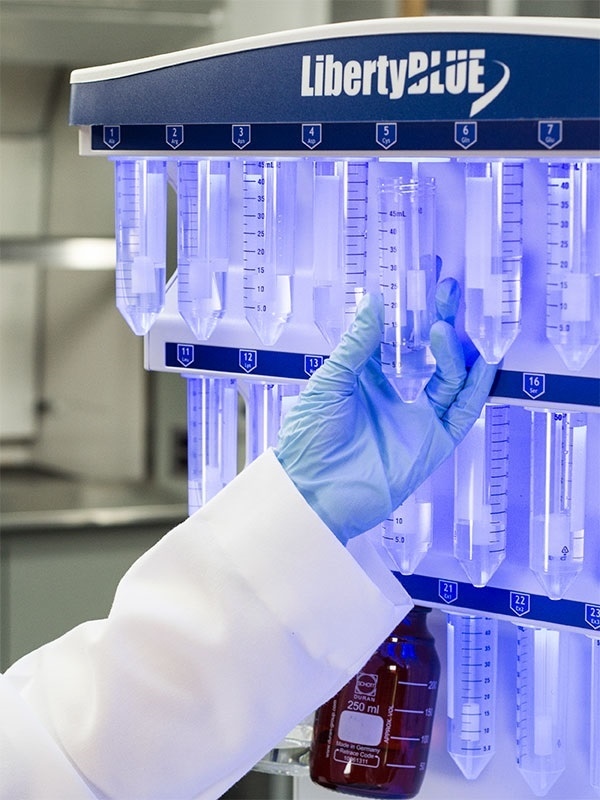In this interview, CEM Corporation talks to News-Medical Life Sciences about using their product the Liberty Blue for Automated High-Efficiency Solid Phase Peptides Synthesis of Modified and Pharmaceutically Relevant Peptides.
Please tell us about CEM Corporation and the work you do.
CEM Corporation is a world-leading provider of microwave instrumentation for applications in analytical and synthetic chemistry. Recently, we have been working on the synthesis of modified and pharmaceutically relevant peptides using an instrument called the Liberty Blue™ automated microwave peptide synthesizer.
There are a variety of synthetic applications that this instrument can be used for including peptide cyclization, peptidomimetic synthesis, and peptide modifications.

What peptide cyclization methods can the Liberty Blue be used for?
Let me begin with RCM and hydrocarbon stapling, a form of cyclization which joins the side chains of two amino acid building blocks. Stapling stabilizes alpha-helices and has been shown to increase protease resistance and cell permeability.
Disulfide bridging is an oxidative bond formation that occurs in many biologically active peptides, most commonly venoms and therapeutics. The disulfide bond stabilizes the secondary structure and, similarly to stapling, can increase protease resistance and target affinity. These bridges can be formed synthetically.
You can also form bonds between thiols to create a peptide with multiple disulphide bonds. Head-to-tail cyclization and side chain-to-side chain condensation can also be performed.
What peptidomimetic synthesis methods can the Liberty Blue be used for?
The Liberty Blue can also be used for peptidomimetic synthesis, in particular, peptoid and peptoid-peptide hybrid synthesis.
Peptoids are polymers with poly-N-substituted glycines. They are resistant to proteolytic degradation, due to the complete substitution of their amide bonds. This makes them an attractive target for pharmaceutical development.
In addition, the secondary structure of peptoids is altered due to a lack of amide hydrogen. Incorporation of a peptoid monomer is not as simple as chain propagation with Fmoc and substituted glycine derivatives. Instead, a two-step acetylation - the nucleophilic displacement approach - is necessary.
First, bromoacetic acid is coupled to the end terminus of a peptide or peptoid monomer. Then, the addition of a primary amine displaces the bromide ion furnishing the end substitute glycine residue. At this point, the peptoid is ready for further channel elongation, with no Fmoc removal required.
Although this two-step procedure is not as simple as a one-step incorporation process, it offers great flexibility. There are thousands of commercially available means that can be employed in peptoid synthesis, opening up many opportunities for chemical discovery.
In addition to peptoid synthesis, another peptide mimetic application that is possible with the Liberty Blue is PNA monomer incorporation.

Please describe the peptide modifications that are achievable with the Liberty Blue?
N-terminal acetylation is a widespread modification found naturally in eukaryotes and prokaryotes, whereby the charge and hydrophobicity of a peptide is altered, affecting its folding properties and target affinity. Protease resistance can also be increased by N-terminal acetylation. Automated N-terminal acetylation is quick and simple.
Incorporation of nonstandard hindered amino acids such as quaternary center containing Aib or nitrogen substituted N-methylalanine is another important process that can be carried out. Incorporation of these types of derivatives is becoming increasingly popular. AIB induces alpha helix formation and, like peptoid monomers, N-methylalanine increases protease resistance and alters the secondary structure.
Incorporation of these building blocks is simple. Adding one of these hindered amino acids requires standard single coupling. If two hindered amino acids are being attached to one another, an extended double coupling is necessary. Attaching a natural amino acid onto a more hindered residue requires a standard double coupling.
We can also incorporate phosphoamino acids. Phosphorylation introduces a phosphate group onto the tyrosine, threonine or serine residues of a peptide. Enzymatic phosphorylation regulates the function of many peptides and proteins. The ability to synthesize phosphorylated peptides is useful for the study of peptide functions and signal transductions.
This phosphorylation process has its advantages over other methods. Traditionally, the production of phosphorylated peptides required synthesis of the unmodified linear sequence, followed by a post-synthetic phosphorylation step. This step is difficult to perform and often yields impure peptides. The introduction of Fmoc derived monobenzyl-protected phospho amino acids has significantly improved the synthetic process.
Derivatives can easily be incorporated using the Liberty Blue and our standard coupling procedures. However, phosphoserine requires room temperature deprotection, as it seems prone to dephosphorylation at high temperatures during deprotection. Upon incorporation of its neighboring amino acids, we can return to using elevated deprotection temperatures.

Please can you describe symmetrical peptide branching?
Symmetrically-branched peptides often have highly desirable physiochemical and biological properties, mainly due to their multivalent binding ability and improved protease resistance.
If you want to synthesize a peptide with four separate chains of identical amino acid sequence, for example, you must look back to when the branching first occurred. Treatment with deprotection solution can furnish two free amines ready for chain elongation.
No specialized cycles or methods are required for this process and all standard single coupling methods can be employed. It is also possible to go further than this level of branching.
These results are astounding because the synthesis of branched peptides via SPPS is often challenging due to the inherent close proximity of elongating peptide chains. Application of microwave energy helps overcome the challenges of steric clash and poor coupling efficiency.

Image Credit:Shutterstock/YurchankaSiarhei
Please can you describe lysine functionalization?
Another application of the Liberty Blue is automated orthogonal lysine deprotection and functionalization. Peptide side chain functionalization such as bioconjugation, tagging and branching are impactful and essential synthetic tools. Many amino acids can be functionalized, but lysine has received particular attention.
Similar to disulfide bond formation requiring orthogonally protected Cys residues, lysine functionalization also requires protection of groups that can be removed, without the rest of the peptide being affected.
The three most common derivatives are probably Lys(Mmt), Lys(ivDde), and Lys(Alloc). While Mmt undergoes deprotection under weak acidic conditions, Lys(Alloc) requires a Palladium catalyst and ivDde requires to dilute hydrazine.
Let us consider asymmetrical peptide branching as an extension of lysine functionalization. The LF Kymera peptide has two distinct points of chain elongation; one is the original peptide chain and the other is an extension of a lysine side chain. This tells you that you would first need to synthesize the linear chain and then deprotect lysine and further elongate.
Lys(ivDde) tends to be the orthogonal derivative of choice, so you would need to use a Boc-protected phenylalanine building block in the last position of the original chain. After capping with this Boc-protected amino acid, you can then deprotect Lys(ivDde) and build the sequence that elongates from this point.
Similarly to symmetrically branched peptide synthesis, you can also take asymmetrical branching a step further.
Automated Microwave Peptide Synthesizer | Liberty Blue
Are there any further peptide modifications that can be achieved using the Liberty Blue?
There are other peptide modifications that are compatible with the Liberty Blue including incorporation of glycoamino acids and orthogonal glutamic acid deprotection and functionalization.
For more information about any of these methods, please visit our website or email us at [email protected].
About CEM Corporation
CEM’s customers come from hugely diverse industries and deliver a staggering array of products and services, but they have one thing in common,They need reliable and cost-effective methods for chemical testing, analysis and monitoring. That’s where CEM comes in. Having pioneered the field of microwave chemistry, we provide products that speed up and automate classical chemistry methods and increase accuracy and repeatability.
- Process Control - Food Compositional Testing and Process / Quality Control
- Analytical - Sample Prep for chemical analysis
- Life Science - Organic & Inorganic Synthesis and Peptide Synthesis
_(003).jpg)